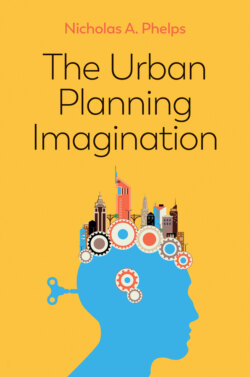Читать книгу The Urban Planning Imagination - Nicholas A. Phelps - Страница 26
The temporalities of urban planning
ОглавлениеMacro-, meso- and micro-level histories imply that multiple temporalities are present in the practice of urban planning. Indeed, it is this that demands the comparative look at urban planning: ‘If town-making, and urban life, are not a steady state of existence but surge and lapse in irregular cycles across the continents, alternative orders of human settlement should be given due attention’ (Kostof, 1991: 31).
‘Planning is … a particular form of governmental technology through which social discipline, ritual, and rhythm are made present in social life, and in which time is materialized’ (Abram, 2014: 129). The activities involved with urban planning often take far longer than the time it takes to build, which prompts Abram to question whether urban planning is an act that aids social adjustment to otherwise disruptive changes. Loss of information (Pollitt, 2000) or of wisdom and churn in urban planning policy (Rozee, 2014) may be products of the generalized speeding up of society (Bertman, 1998). Indeed, Friend and Hickling (2005) identify turbulence, urgency and overload as some of the very real pressures affecting urban planning processes. Interestingly, urban planning processes and plans themselves have become more, not less, various and abundant despite such pressures.
There are several different temporalities within any given planning system. There are the near instantaneous planning and urban service delivery decisions that are being made as a result of real-time data and visualization of it. But is this planning? Is it simply crisis management? Visualizations of real-time data convey nothing of urban planning’s normative glance to a more just or sustainable future. There is a danger of being stuck in a permanent planning present of resolving day-to-day hassles rather than the envisioning of alternative urban futures.
There is the time frame on which plan making ought to take place if it is to command widespread support. There are separate political or bureaucratic cycles over which the preparing, making and adopting of planning documents must take place, and the time frames over which plans are monitored, evaluated and revised. It is clear that these different temporalities of planning themselves conflict, and this alone should alert us to the fundamental importance of the political and institutional support that urban planning needs to draw upon if it is to be anything at all.
There are the spans of time over which changes happen outside the planning process itself. Forecasts of population growth, housing needs and residential land-use allocations can often be exposed by fluctuations of business and property investment cycles, let alone Kondratieff long waves which generate severe economic crises.2 Here the influence of developers as club actors on and in urban planning processes orchestrated by the state and affecting citizens becomes apparent (Charney, 2012). The etymology of the word ‘crisis’ in the Greek krisis – meaning decision – is itself suggestive of planning. Crises are shared experiences calling forth the collective actions that we take as the signature of urban planning. It may be true to say that ‘crises have become a normative expectation in contemporary societies’ (Hall and Ince, 2018: 9). Certainly ‘disruption’ now figures prominently in writing on the implications of big and real-time data for urban planning (Batty, 2018; Hall and Tewdwr-Jones, 2020).
To be effective, planners need to be able to contribute on a given issue for a period of time (Krumholz, 1982). The problem is that churn is a feature of the careers of trained urban planners regardless of which citizen, club or state actors they work in the service of. Even the lesser time frames discussed above may exceed the tenure of individual planners. The meso-historical time frames needed to resolve some urban planning challenges far exceed those of particular institutional configurations of statutory planning, let alone the lives of individual citizens or trained urban planners. For example, ‘even though the science and use of scenarios in climate change projections might suggest the need for a long-term view, UK planners and planning authorities have … been inhibited in taking a long-term perspective or in engaging with futures thinking’ (Wilson, 2009: 223). In macro-historical terms, the urban planning imagination is revealed as seeking for resilience and gradual adjustment to climate change and events, but it is questionable whether and how it can respond in the short term to the increasing frequency and greater severity of climate events (Halsnæs and Laursen, 2009: 83).
Across the global south, time is a resource that citizens know how to exploit. Inaction by states, or their inabilities to fully enforce regulations, become opportunities for income generation in tactical adjustments by street vendors (Recio, 2021). Waiting for the state to act opens the way to the autoconstruction of housing (Oldfield and Greyling, 2015). In both instances the citizen–state relationship is reconstituted. The temporal interstices of urban planning are essential to understanding some of the creative energies of global south citizens in resisting some of the institutionalized divisiveness of statutory planning.
Statutory planners are adept at making adjustments across increments of time in trying to solve the complexities of urban development (Hoch, 2019: 51) and have become more adept at utilizing the interstices of planning processes when sanctioning temporary uses of spaces (Madanipour, 2017). Across the global north, temporary uses of urban space can introduce experiences that rub up against the fixtures of statutory urban planning practices and in which difference is affirmed (chapter 4).
